Kale – the superfood that’s super easy to grow
If you like eating kale, you may be interested to know how to grow it yourself. The good news is that it’s easy to grow outside in the UK. Kale can be grown in the ground or in a pot, and can be planted directly in the soil or in a pot on a balcony or patio.
Kale is a versatile kitchen staple and is super easy for beginners as well as seasoned veg plotters. From frizzy red and curly green, to the majestic slaty leaves of Cavolo Nero, many varieties are available to grow in the British climate.
Best of all they can be grown anywhere with a bit of outside space. Plant direct in the soil in veg plots or in a container on a balcony or patio. They aren’t fussy about soil and work in sunny or shady spots. The stately or frilly leaves are considered by many to be ornamental enough to hold their own amongst flowers and shrubs.
Cheap to grow from seed you can supply yourself with leaves throughout autumn, winter and into spring, harvesting whole or picking side shoots to add to your stir fries and salads.
How to grow Kale
Kale can be bought as baby plants called plugs but is easily and cheaply grown from seed. It germinates very easily and a packet of seeds usually costs £2-3. You can sow the seeds indoors from March or outdoors from May.
Which way you choose will depend on your circumstances so read the following two methods and take your pick. Whatever you choose, don’t sow the entire packet of seeds unless you have room to grow dozens of plants.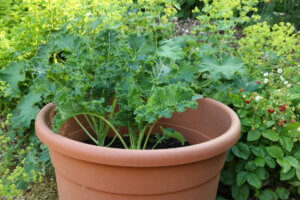
Method 1 – Grow kale seeds direct in the ground or in a pot
This is the simplest way, requiring no kit but you will need to wait until April or May, when the ground will have warmed up enough. Dig over your chosen area and break up the soil to produce a fine bed for your kale. If you’ve got a veg patch you may want to sow the seed in a line. This makes it easier to distinguish the seedlings from any weeds that may spring up. You can run your finger or trowel along a stick to get a straight line. Empty the tiny seeds into the palm of your hand then pinch them to sow thinly along the row and cover lightly with soil. Water in gently.
If growing amongst other ornamental garden plants, you won’t want to sow in a line. Instead you could sow them in a circle or cross shape so that you will know these are your kale seedlings amongst your other plants.
If growing in a container, choose a largish pot with plenty of space for the roots to grow and fill with multi-purpose compost. Sprinkle the seeds on the surface and cover with a fine layer of compost. Plants in pots dry out quicker than in the ground so make sure you keep them watered. If you grow them for a long season, feeding with a liquid seaweed food may help them as the nutrients in the compost will be depleted after a while.
Once germinated you will need to thin your seedlings as you are unlikely to have space to grow all of them. Cavolo Nero will grow to be 90cm x 60cm in size but even the dwarf varieties will be the size of a beach ball. The great news is that you can eat the seedlings you thin out. They taste delicious.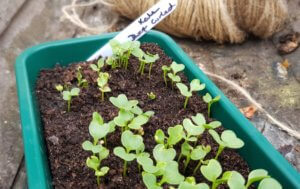
Method 2 – Grow kale in a seed tray indoors then plant out
Seeds can be started off earlier indoors so your crop may be ready slightly earlier. Certainly, you will be able to eat the thinning and side shoots earlier if you sow indoors. Sow from March.
I usually sow in a small pot or seed tray filled with multipurpose compost and patted down to make a smooth surface. I then sprinkle some seeds on the surface and cover lightly with more compost and water in. Leave in a cool place and wait to germinate.
When the seedlings are large enough to handle, I prick them out into individual pots or modules filled with multi-purpose compost to grow on. I then eat the seedlings I don’t transplant – tasty and thrifty. I gradually get the plants used to the outdoors by moving them in and out of the house in warmer weather. They can be plant out in the garden or pot in late May or June. Plant in the ground leaving enough space for them to grow, and if growing in a container I choose a fairly large one.
Harvesting
Kale is a very versatile vegetable and can be eaten at all stages of maturity, providing baby leaf crops in summer, then through autumn and winter into spring. I like to eat the tiny seedlings or pick a few individual leaves from the plant as it grows, throwing them into a stir-fry or soup. Even if you harvest the entire crown of the plant, further side shoots will continue to grow. The flavour of the kale is improved once first frosts have started, as the cold releases natural sugars in the leaves.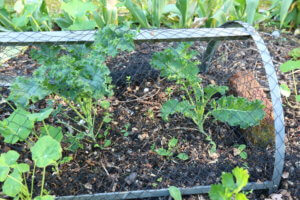
A word about pigeons
As with other members of the brassica family, kale is a tasty treat for pigeons. They can be a big problem as they peck at and strip the young leaves of a kale seedling. I found my row of healthy seedlings stripped a few days after planting. The outer leaves were severely damaged but the inner ones were fine and I knew they would continue to grow if protected.
The only way to successfully protect the seedlings is to net them. I had some old metal frames that I put over the rows and then covered them with some old netting I had in the shed. I had to remove this once the plants grew tall as they were beginning to push through the netting. I expect they will now have sufficient structure to withstand pigeon attack as I have grow large plants here before with no problem. Strangely the two plants in a pot were unaffected – maybe the pigeons like to be on the ground to perform their vandalism, rather than perched on the edge of a pot.
Varieties to try
Nero di Toscano – A Cavolo Nero variety with long greeny purple leaves. Best harvested once the frosts have improved the flavour.
Redbor F1 – This is a frilly red variety, reminiscent of sea corals. Smaller than most varieties, it won’t grow taller than 60cm and could make a good choice for pots.
Dwarf green curled – a smaller variety with good flavour. Suitable for container growing as well as in the open garden.
Emerald Ice – A very pretty variety with white veined leaves, edged in green, giving it a variegated appearance.
Superfood Mixed – Can’t decide on a variety? This seed mix contains varieties of curly red or green Kale as well as Cavolo Nero.
Mail-order Suppliers of kale seed
Not all companies supply all varieties so shop around for your chosen one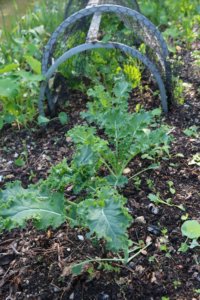
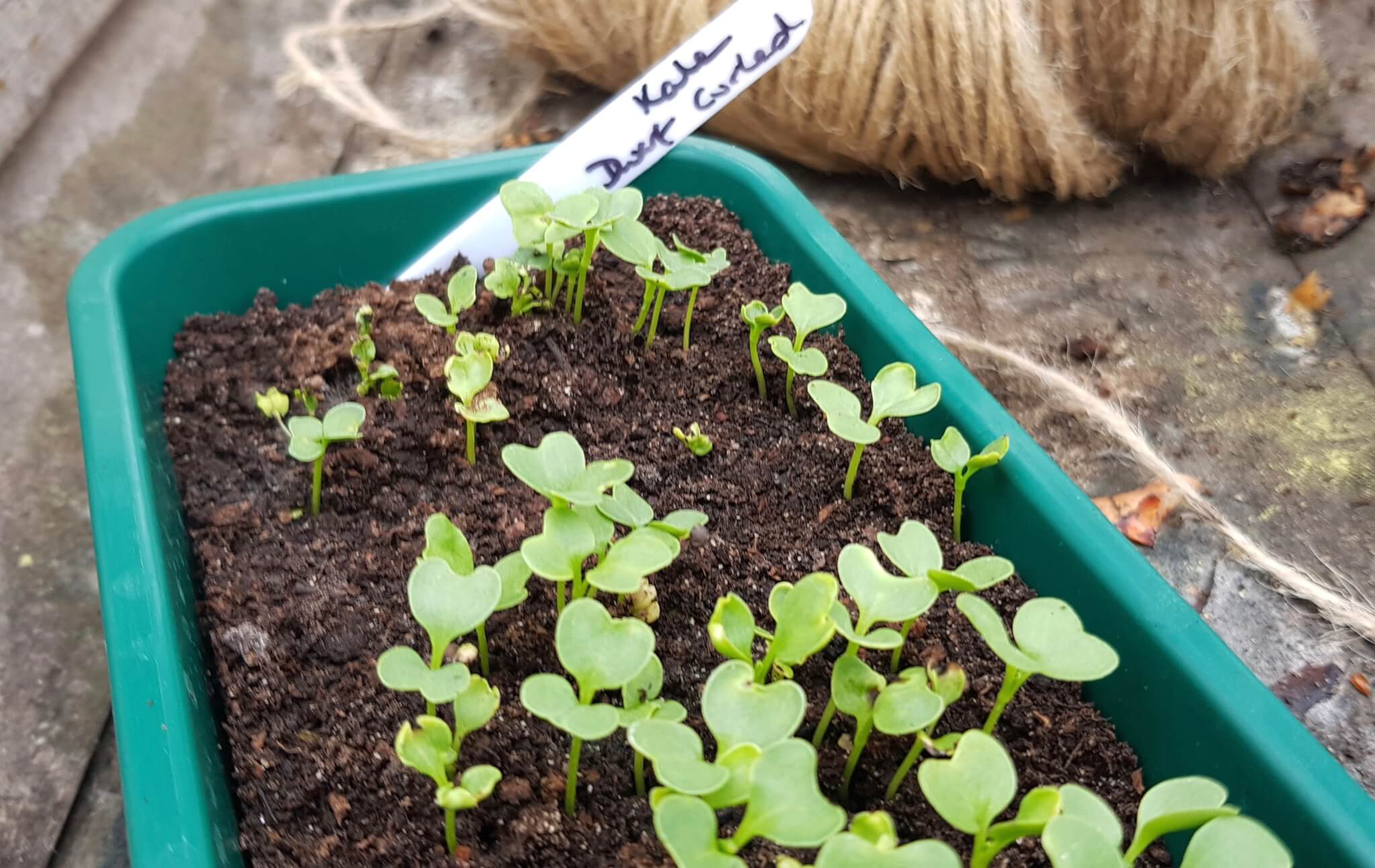
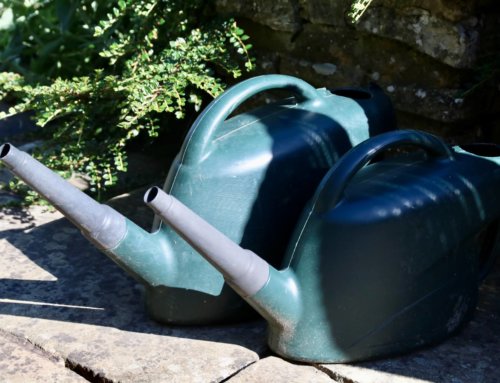
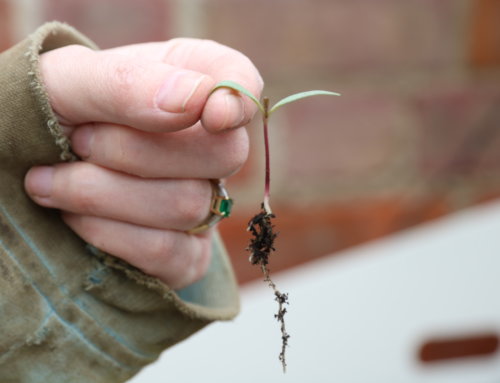
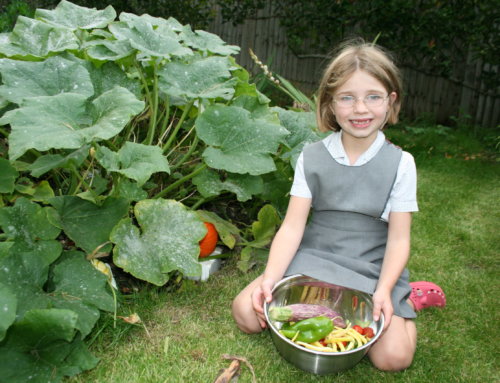
[…] Kale grows quite happily in potsImage: Teabreak Gardener […]
Never grown kale before .. can I also grow carrots in the same raised bed ?
Hi Jean. It depends how big your raised bed is and which kale you grow but there’s usually room for a line of carrots somewhere. Give it a try!
How big should the pot be? What is your recommendation on the smallest pot size?
Hi, I would go for as large as you can fit in your garden or terrace. The minimum I would try would probably be 40cm diameter per plant. I hope that helps!
Great idea to grow your own veggies. We’re going to give it a shot in our pot & container.